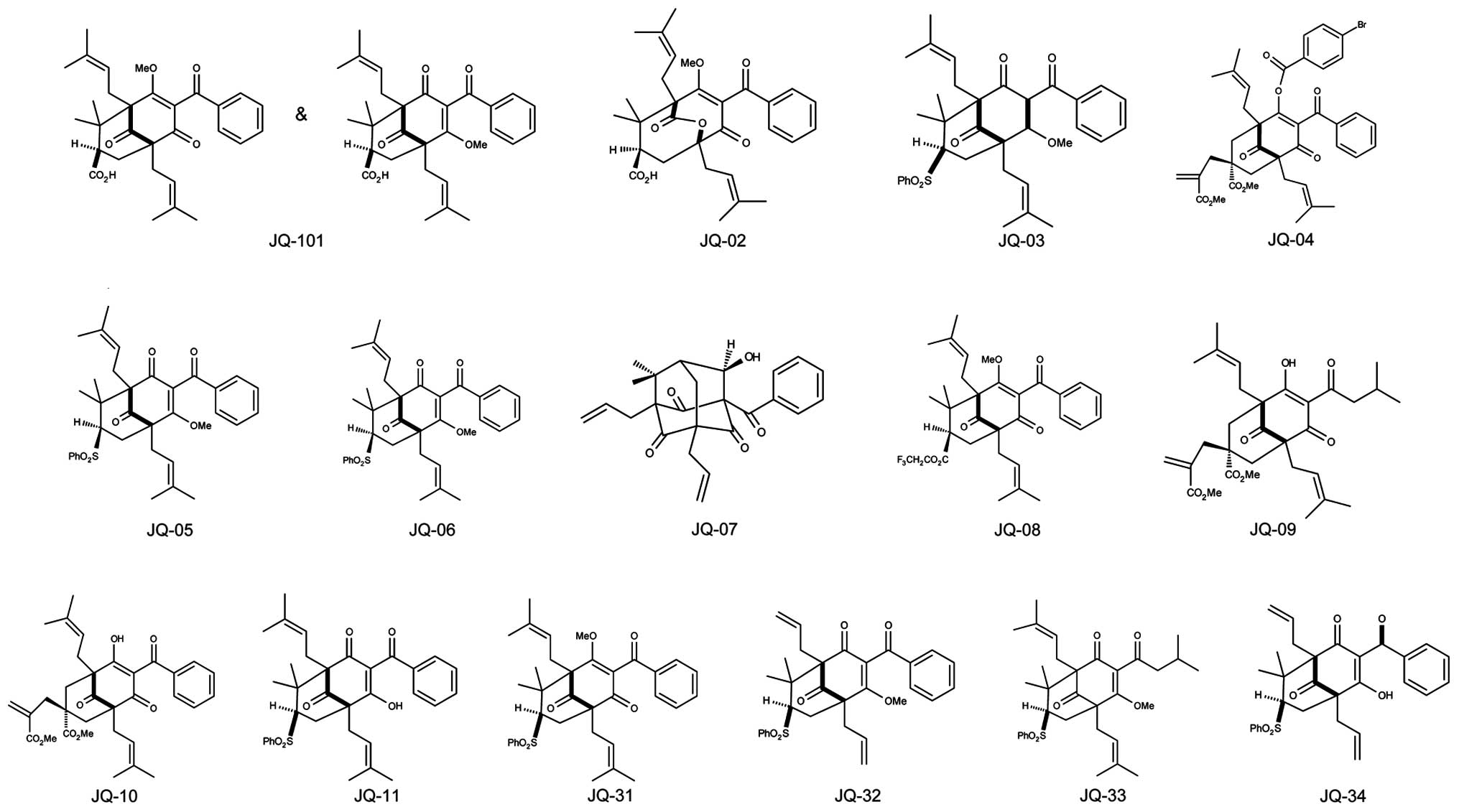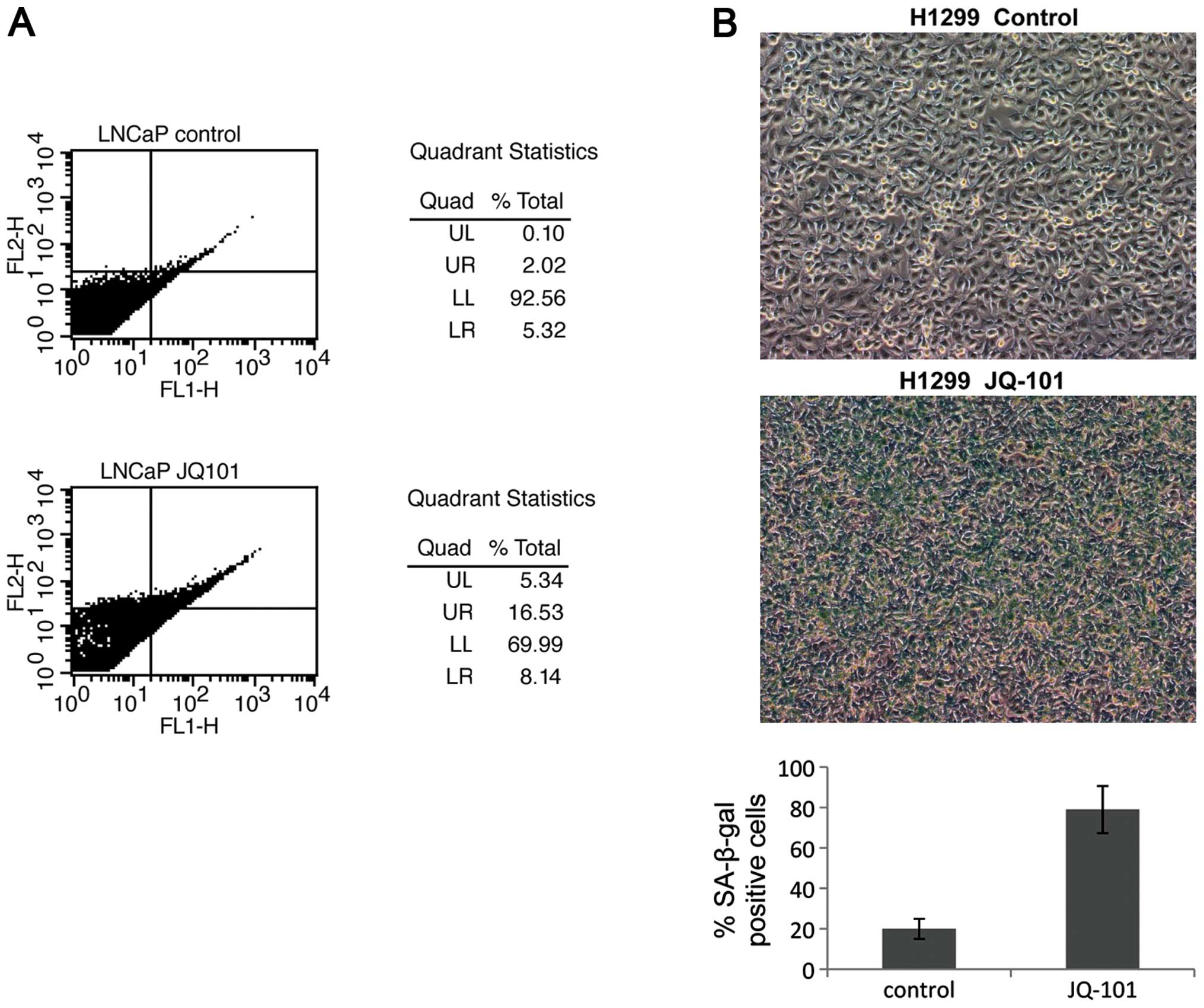|
1
|
Bordone L and Guarente L: Calorie
restriction, SIRT1 and metabolism: understanding longevity. Nat Rev
Mol Cell Biol. 6:298–305. 2005. View
Article : Google Scholar : PubMed/NCBI
|
|
2
|
Inoue T, Hiratsuka M, Osaki M and Oshimura
M: The molecular biology of mammalian SIRT proteins: SIRT2 in cell
cycle regulation. Cell Cycle. 6:1011–1018. 2007. View Article : Google Scholar : PubMed/NCBI
|
|
3
|
Saunders LR and Verdin E: Sirtuins:
critical regulators at the crossroads between cancer and aging.
Oncogene. 26:5489–5504. 2007. View Article : Google Scholar : PubMed/NCBI
|
|
4
|
Donmez G and Guarente L: Aging and
disease: connections to sirtuins. Aging Cell. 9:285–290. 2010.
View Article : Google Scholar : PubMed/NCBI
|
|
5
|
Bosch-Presegue L and Vaquero A: The dual
role of sirtuins in cancer. Genes Cancer. 2:648–662. 2011.
View Article : Google Scholar : PubMed/NCBI
|
|
6
|
Knight JR and Milner J: SIRT1, metabolism
and cancer. Curr Opin Oncol. 24:68–75. 2012. View Article : Google Scholar : PubMed/NCBI
|
|
7
|
Chu F, Chou PM, Zheng X, Mirkin BL and
Rebbaa A: Control of multidrug resistance gene mdr1 and cancer
resistance to chemotherapy by the longevity gene sirt1. Cancer Res.
65:10183–10187. 2005. View Article : Google Scholar : PubMed/NCBI
|
|
8
|
Kojima K, Ohhashi R, Fujita Y, et al: A
role for SIRT1 in cell growth and chemoresistance in prostate
cancer PC3 and DU145 cells. Biochem Biophys Res Commun.
373:423–428. 2008. View Article : Google Scholar : PubMed/NCBI
|
|
9
|
Lee SM, Bae JH, Kim MJ, et al:
Bcr-Abl-independent imatinib-resistant K562 cells show aberrant
protein acetylation and increased sensitivity to histone
deacetylase inhibitors. J Pharmacol Exp Ther. 322:1084–1092. 2007.
View Article : Google Scholar : PubMed/NCBI
|
|
10
|
Liang XJ, Finkel T, Shen DW, Yin JJ,
Aszalos A and Gottesman MM: SIRT1 contributes in part to cisplatin
resistance in cancer cells by altering mitochondrial metabolism.
Mol Cancer Res. 6:1499–1506. 2008. View Article : Google Scholar
|
|
11
|
Marshall GM, Liu PY, Gherardi S, et al:
SIRT1 promotes N-Myc oncogenesis through a positive feedback loop
involving the effects of MKP3 and ERK on N-Myc protein stability.
PLoS Genet. 7:e10021352011. View Article : Google Scholar : PubMed/NCBI
|
|
12
|
Suzuki K, Hayashi R, Ichikawa T, et al:
SRT1720, a SIRT1 activator, promotes tumor cell migration, and lung
metastasis of breast cancer in mice. Oncol Rep. 27:1726–1732.
2012.PubMed/NCBI
|
|
13
|
Gabr AG, Goto H, Hanibuchi M, et al:
Erlotinib prevents experimental metastases of human small cell lung
cancer cells with no epidermal growth factor receptor expression.
Clin Exp Metastasis. 29:207–216. 2012. View Article : Google Scholar
|
|
14
|
Byles V, Zhu L, Lovaas JD, et al: SIRT1
induces EMT by cooperating with EMT transcription factors and
enhances prostate cancer cell migration and metastasis. Oncogene.
31:4619–4629. 2012. View Article : Google Scholar : PubMed/NCBI
|
|
15
|
Zhang Y, Zhang M, Dong H, et al:
Deacetylation of cortactin by SIRT1 promotes cell migration.
Oncogene. 28:445–460. 2009. View Article : Google Scholar : PubMed/NCBI
|
|
16
|
Nakane K, Fujita Y, Terazawa R, et al:
Inhibition of cortactin and SIRT1 expression attenuates migration
and invasion of prostate cancer DU145 cells. Int J Urol. 19:71–79.
2012. View Article : Google Scholar
|
|
17
|
Holloway KR, Calhoun TN, Saxena M, et al:
SIRT1 regulates Dishevelled proteins and promotes transient and
constitutive Wnt signaling. Proc Natl Acad Sci USA. 107:9216–9221.
2010. View Article : Google Scholar : PubMed/NCBI
|
|
18
|
Lovaas JD, Zhu L, Chiao CY, Byles V,
Faller DV and Dai Y: SIRT1 enhances matrix metalloproteinase-2
expression and tumor cell invasion in prostate cancer cells.
Prostate. 73:522–530. 2013. View Article : Google Scholar : PubMed/NCBI
|
|
19
|
Potente M, Ghaeni L, Baldessari D, et al:
SIRT1 controls endothelial angiogenic functions during vascular
growth. Genes Dev. 21:2644–2658. 2007. View Article : Google Scholar : PubMed/NCBI
|
|
20
|
Potente M and Dimmeler S: Emerging roles
of SIRT1 in vascular endothelial homeostasis. Cell Cycle.
7:2117–2122. 2008. View Article : Google Scholar : PubMed/NCBI
|
|
21
|
Jang KY, Hwang SH, Kwon KS, et al: SIRT1
expression is associated with poor prognosis of diffuse large
B-cell lymphoma. Am J Surg Pathol. 32:1523–1531. 2008. View Article : Google Scholar : PubMed/NCBI
|
|
22
|
Huffman DM, Grizzle WE, Bamman MM, et al:
SIRT1 is significantly elevated in mouse and human prostate cancer.
Cancer Res. 67:6612–6618. 2007. View Article : Google Scholar : PubMed/NCBI
|
|
23
|
Zhao G, Cui J, Zhang JG, et al: SIRT1 RNAi
knockdown induces apoptosis and senescence, inhibits invasion and
enhances chemosensitivity in pancreatic cancer cells. Gene Ther.
18:920–928. 2011. View Article : Google Scholar : PubMed/NCBI
|
|
24
|
Cha EJ, Noh SJ, Kwon KS, et al: Expression
of DBC1 and SIRT1 is associated with poor prognosis of gastric
carcinoma. Clin Cancer Res. 15:4453–4459. 2009. View Article : Google Scholar : PubMed/NCBI
|
|
25
|
DiMeo TA, Anderson K, Phadke P, et al: A
novel lung metastasis signature links Wnt signaling with cancer
cell self-renewal and epithelial-mesenchymal transition in
basal-like breast cancer. Cancer Res. 69:5364–5373. 2009.
View Article : Google Scholar
|
|
26
|
Lee H, Kim KR, Noh SJ, et al: Expression
of DBC1 and SIRT1 is associated with poor prognosis for breast
carcinoma. Hum Pathol. 42:204–213. 2011. View Article : Google Scholar : PubMed/NCBI
|
|
27
|
Chen J, Zhang B, Wong N, et al: Sirtuin 1
is upregulated in a subset of hepatocellular carcinomas where it is
essential for telomere maintenance and tumor cell growth. Cancer
Res. 71:4138–4149. 2011. View Article : Google Scholar : PubMed/NCBI
|
|
28
|
Kriegl L, Vieth M, Kirchner T and Menssen
A: Up-regulation of c-MYC and SIRT1 expression correlates with
malignant transformation in the serrated route to colorectal
cancer. Oncotarget. 3:1182–1193. 2012.PubMed/NCBI
|
|
29
|
Tseng RC, Lee CC, Hsu HS, Tzao C and Wang
YC: Distinct HIC1-SIRT1-p53 loop deregulation in lung squamous
carcinoma and adenocarcinoma patients. Neoplasia. 11:763–770.
2009.PubMed/NCBI
|
|
30
|
Bitterman KJ, Anderson RM, Cohen HY,
Latorre-Esteves M and Sinclair DA: Inhibition of silencing and
accelerated aging by nicotinamide, a putative negative regulator of
yeast sir2 and human SIRT1. J Biol Chem. 277:45099–45107. 2002.
View Article : Google Scholar : PubMed/NCBI
|
|
31
|
Grozinger CM, Chao ED, Blackwell HE,
Moazed D and Schreiber SL: Identification of a class of small
molecule inhibitors of the sirtuin family of NAD-dependent
deacetylases by phenotypic screening. J Biol Chem. 276:38837–38843.
2001. View Article : Google Scholar : PubMed/NCBI
|
|
32
|
Heltweg B, Gatbonton T, Schuler AD, et al:
Antitumor activity of a small-molecule inhibitor of human silent
information regulator 2 enzymes. Cancer Res. 66:4368–4377. 2006.
View Article : Google Scholar : PubMed/NCBI
|
|
33
|
Solomon JM, Pasupuleti R, Xu L, et al:
Inhibition of SIRT1 catalytic activity increases p53 acetylation
but does not alter cell survival following DNA damage. Mol Cell
Biol. 26:28–38. 2006. View Article : Google Scholar : PubMed/NCBI
|
|
34
|
Lain S, Hollick JJ, Campbell J, et al:
Discovery, in vivo activity, and mechanism of action of a
small-molecule p53 activator. Cancer Cell. 13:454–463. 2008.
View Article : Google Scholar : PubMed/NCBI
|
|
35
|
Bedalov A, Gatbonton T, Irvine WP,
Gottschling DE and Simon JA: Identification of a small molecule
inhibitor of Sir2p. Proc Natl Acad Sci USA. 98:15113–15118. 2001.
View Article : Google Scholar : PubMed/NCBI
|
|
36
|
Choi G, Lee J, Ji JY, et al: Discovery of
a potent small molecule SIRT1/2 inhibitor with anticancer effects.
Int J Oncol. 43:1205–1211. 2013.PubMed/NCBI
|
|
37
|
Lara E, Mai A, Calvanese V, et al:
Salermide, a Sirtuin inhibitor with a strong cancer-specific
proapoptotic effect. Oncogene. 28:781–791. 2009. View Article : Google Scholar : PubMed/NCBI
|
|
38
|
Suzuki T, Imai K, Nakagawa H and Miyata N:
2-Anilinobenzamides as SIRT inhibitors. ChemMedChem. 1:1059–1062.
2006. View Article : Google Scholar : PubMed/NCBI
|
|
39
|
Gey C, Kyrylenko S, Hennig L, et al:
Phloroglucinol derivatives guttiferone G, aristoforin, and
hyperforin: inhibitors of human sirtuins SIRT1 and SIRT2. Angew
Chem Int Ed Engl. 46:5219–5222. 2007. View Article : Google Scholar : PubMed/NCBI
|
|
40
|
Zhang Y, Zhang Q, Zeng SX, Zhang Y, Mayo
LD and Lu H: Inauhzin and Nutlin3 synergistically activate p53 and
suppress tumor growth. Cancer Biol Ther. 13:915–924. 2012.
View Article : Google Scholar : PubMed/NCBI
|
|
41
|
Qi J and Porco JA Jr: Rapid access to
polyprenylated phloroglucinols via alkylative
dearomatization-annulation: total synthesis of (+/−)-clusianone(1).
J Am Chem Soc. 129:12682–12683. 2007.PubMed/NCBI
|
|
42
|
Mitasev B and Porco JA Jr:
Manganese(III)-mediated transformations of phloroglucinols: a
formal oxidative [4 + 2] cycloaddition leading to
bicyclo[2.2.2]octadiones. Org Lett. 11:2285–2288. 2009.PubMed/NCBI
|
|
43
|
Zhang Q and Porco JA Jr: Total synthesis
of (+/−)-7-epi-nemorosone. Org Lett. 14:1796–1799. 2012.
|
|
44
|
Biber N, Mows K and Plietker B: The total
synthesis of hyper-papuanone, hyperibone L, epi-clusianone and
oblongifolin A. Nat Chem. 3:938–942. 2011. View Article : Google Scholar : PubMed/NCBI
|
|
45
|
Vaziri H, Dessain SK, Ng Eaton E, et al:
hSIR2(SIRT1) functions as an NAD-dependent p53 deacetylase. Cell.
107:149–159. 2001. View Article : Google Scholar : PubMed/NCBI
|
|
46
|
Noh SJ, Baek HA, Park HS, et al:
Expression of SIRT1 and cortactin is associated with progression of
non-small cell lung cancer. Pathol Res Pract. 209:365–370. 2013.
View Article : Google Scholar : PubMed/NCBI
|
|
47
|
Liu T, Liu PY and Marshall GM: The
critical role of the class III histone deacetylase SIRT1 in cancer.
Cancer Res. 69:1702–1705. 2009. View Article : Google Scholar : PubMed/NCBI
|
|
48
|
Li L, Wang L, Li L, et al: Activation of
p53 by SIRT1 inhibition enhances elimination of CML leukemia stem
cells in combination with imatinib. Cancer Cell. 21:266–281. 2012.
View Article : Google Scholar : PubMed/NCBI
|
|
49
|
Kalle AM, Mallika A, Badiger J, Alinakhi,
Talukdar P and Sachchidanand: Inhibition of SIRT1 by a small
molecule induces apoptosis in breast cancer cells. Biochem Biophys
Res Commun. 401:13–19. 2010. View Article : Google Scholar : PubMed/NCBI
|
|
50
|
Sun Y, Sun D, Li F, et al: Downregulation
of Sirt1 by antisense oligonucleotides induces apoptosis and
enhances radiation sensitization in A549 lung cancer cells. Lung
Cancer. 58:21–29. 2007. View Article : Google Scholar : PubMed/NCBI
|
|
51
|
Ota H, Tokunaga E, Chang K, et al: Sirt1
inhibitor, Sirtinol, induces senescence-like growth arrest with
attenuated Ras-MAPK signaling in human cancer cells. Oncogene.
25:176–185. 2006.PubMed/NCBI
|
|
52
|
Huang J, Gan Q, Han L, et al: SIRT1
overexpression antagonizes cellular senescence with activated
ERK/S6k1 signaling in human diploid fibroblasts. PLoS One.
3:e17102008. View Article : Google Scholar : PubMed/NCBI
|
|
53
|
Jang SY, Kim SY and Bae YS: p53
deacetylation by SIRT1 decreases during protein kinase CKII
downregulation-mediated cellular senescence. FEBS Lett.
585:3360–3366. 2011. View Article : Google Scholar : PubMed/NCBI
|
|
54
|
Saxena M, Dykes SS, Malyarchuk S, Wang AE,
Cardelli JA and Pruitt K: The sirtuins promote Dishevelled-1
scaffolding of TIAM1, Rac activation and cell migration. Oncogene.
Dec 23–2013.(Epub ahead of print).
|















